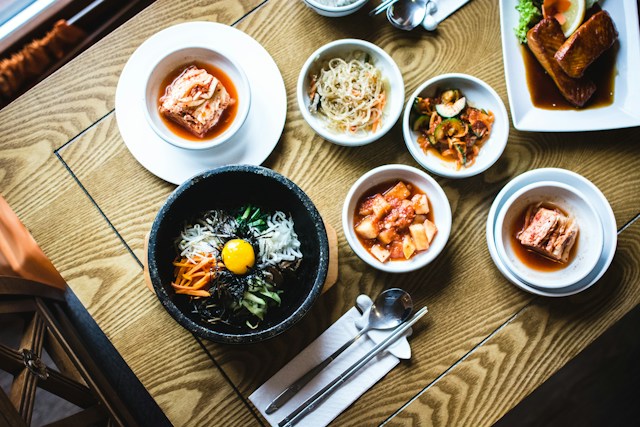Korean cuisine and its must-try dishes

Welcome to the vibrant world of Korean cuisine that is buzzing with intense flavors, colorful presentation, and a unique blend of tastes. Over the years, Korean cuisine has evolved under a complex set of environmental, social, and cultural influences, making it a fascinating part of the country’s cultural heritage. Let’s explore its culinary delights and the must-try dishes that it offers.
A Culinary Journey through History
Before diving into the treats that Korean cuisine offers, it’s essential to understand its journey through history. Korean cuisine has a rich history that dates back to ancient times. Influenced by its geography, climate, and the changing seasons, Korean cuisine offers a diverse range of dishes that are a treat for the senses.
En parallèle : How to prepare healthy meals for the whole family
The unique Korean cooking techniques, preparation methods, and presentation styles have evolved over centuries, leading to a cuisine that is distinctly different from its Asian counterparts. From the royal gourmet feasts during the Joseon Dynasty to the simple, hearty meals of the common folks, Korean cuisine has always been deeply rooted in the country’s cultural and social fabric.
The Basis of Korean Cuisine
At the heart of Korean cuisine are a few key ingredients and flavors. Rice, fermented vegetables (kimchi), soy sauce, sesame oil, garlic, ginger, and chili pepper paste (gochujang) form the backbone of Korean food. These ingredients are used in nearly every dish, lending a distinct flavor profile that is both spicy and savory.
A lire aussi : Recipes for a romantic home dinner
The Korean table setting, known as ‘bapsang’, is another unique aspect of this cuisine. A typical meal consists of a bowl of rice, a bowl of soup, and several side dishes known as banchan. The number and variety of banchan can vary, but it often includes an assortment of fermented, pickled, and fresh vegetables.
Must-Try Dishes in Korean Cuisine
When exploring Korean cuisine, there are several dishes that you must try. These dishes embody the rich flavors and culinary traditions of Korea.
Bibimbap
One of the most popular dishes in Korean cuisine is Bibimbap. This dish is a colorful mix of rice, sautéed vegetables, meat, and a spicy chili pepper paste topped with a raw or fried egg. The ingredients are beautifully arranged in a bowl and are mixed together before eating. The combination of flavors and textures makes Bibimbap a favorite among locals and tourists alike.
Kimchi
No Korean meal is complete without Kimchi. This fermented vegetable dish is a staple in Korean cuisine. Cabbage is the most common vegetable used, though radishes, cucumbers, or other vegetables may also be used. The vegetables are fermented with chili pepper, garlic, ginger, and salt, resulting in a tangy, spicy, and slightly sweet dish that is packed with probiotics.
Samgyeopsal
Samgyeopsal, or grilled pork belly, is another must-try dish. This dish is typically served at barbecue restaurants where diners cook the meat themselves on a grill built into the dining table. The crispy, fatty slices of pork belly are often wrapped in lettuce leaves with garlic, chili paste, and a sliver of kimchi, creating a burst of flavors in your mouth.
The Charm of Street Food
Korean street food is an experience in itself. The bustling street food stalls, known as ‘pojangmacha’, offer a variety of snacks and small meals. From spicy rice cakes (Tteokbokki) and Korean-style pancakes (Pajeon) to skewered meats and fried snacks, the street food scene in Korea is vibrant and exciting.
The Rise of Korean Fusion Cuisine
In recent years, Korean fusion cuisine has gained popularity worldwide. This trend blends traditional Korean flavors with other cuisines, creating innovative dishes that appeal to a global palate. An example is the Korean-Mexican fusion that led to the creation of the famous Korean tacos.
Korean fusion cuisine showcases the versatility of Korean flavors and their ability to blend harmoniously with other cuisines. This trend has brought Korean cuisine to the forefront of the global culinary scene, making it a favorite among food lovers around the world.
In essence, Korean cuisine offers an immersive cultural experience that goes beyond just a meal. It’s a journey through the country’s rich history, traditions, and culinary creativity, making it an adventure in itself. So, whether you’re planning a trip to Korea or exploring Korean cuisine from your kitchen, make sure to relish the flavors and experiences that these must-try dishes offer.
Korean Cuisine and Health
The health benefits of Korean cuisine are numerous and noteworthy. The extensive use of fermented food items, like Kimchi, and bean pastes in the cuisine adds probiotics to the diet, which are essential for gut health and boosting immunity. The cuisine is also low in fats and high in fiber, making it a balanced option for those keen on maintaining a healthy diet.
Korean meals often include a variety of vegetables, both fresh and fermented, providing essential vitamins and minerals. Seafood, a common ingredient in Korean dishes, is rich in omega-3 fatty acids which are beneficial for heart health. Many Korean dishes are spiced with garlic and ginger, both of which have numerous medicinal properties. For instance, garlic is known for its anti-inflammatory properties while ginger can aid digestion.
Furthermore, the meal structure of Korean cuisine, with its emphasis on small plates or banchan, encourages portion control and a balanced intake of different food groups. This aligns with the dietary guidelines of many health organizations that recommend consuming a variety of foods for optimal health.
The Global Influence of Korean Cuisine
Another intriguing aspect of Korean cuisine is its increasing global influence. Korean restaurants are becoming ubiquitous in cities around the world, offering a chance for people to explore this unique cuisine. The rising popularity of K-pop and Korean dramas has also played a significant role in promoting Korean food internationally.
But it’s not just the traditional Korean dishes that are gaining recognition. The advent of Korean fusion cuisine, blending traditional Korean flavors with international ones, has also garnered much interest. Food items like Korean tacos, a blend of Korean and Mexican flavors, have become popular street food in many countries.
Furthermore, Korean cuisine is also making its mark in the world of fine dining. Top chefs are incorporating Korean ingredients and flavors into their menus, showcasing the versatility of this cuisine. This growing global influence of Korean cuisine is a testament to its unique flavors and culinary traditions.
Conclusion
In conclusion, Korean cuisine is a genre that is deeply intertwined with the country’s history, culture, and traditions. Its unique combination of flavors, emphasis on balance and variety, and health benefits make it an intriguing culinary journey. The globally growing popularity of Korean food is a testament to its universal appeal. Whether you are a food enthusiast keen to explore new cuisines or a culinary expert looking to experiment with flavors, Korean cuisine offers a plethora of options. From the hearty Bibimbap to the tangy Kimchi and the delightful street food, Korean cuisine is a must-try for a fulfilling gastronomic adventure.
